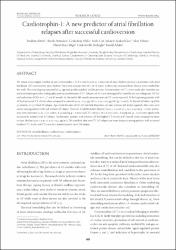Cardiotrophin-1: A new predictor of atrial fibrillation relapses after successful cardioversion

Göster/
Tarih
2015Yazar
Altun, İbrahimPamukcu, Burak
Yıldız, Cenk Eray
Arkaya, Selda Can
Güz, Göksel
Yılmaz, Akar
Adalet, Kamil
Üst veri
Tüm öğe kaydını gösterÖzet
We aimed to investigate whether or not cardiotrophin-1 (CT-1) can be used as a predictor of sinus rhythm constancy in patients with atrial fibrillation (AF) converted to sinus rhythm. Thirty two patients with AF (48-78 years), without any structural heart disease were enrolled for the study. The control group consisted of 32, age and gender matched healthy persons. Measurements of CT-1 were made after transthoracic and transesophageal echocardiography prior to cardioversion (CV). Relapses of AF were investigated by monthly electrocardiograms (ECGs) and ambulatory ECGs at 1st, 3rd, and 6th month. At the end of 6th month, measurements of CT-1 were repeated. At the beginning patients with AF had increased CT-1 levels when compared to controls (0.94 +/- 0.32 pg/mL vs. 0.30 +/- 0.12 pg/mL, [p < 0.001]). At the end of follow-up of the 32 patients, 17 (53%) had AF relapse. Age, initial duration of AF, left ventricle diameters, ejection fraction, left atrium appendix flow rates were similar among patients with and without AF relapse. However, basal left atrium diameter (4.24 +/- 0.14 cm vs. 4.04 +/- 0.22 cm, p = 0.005), pulmonary artery pressure (32.82 +/- 5 vs. 28.60 +/- 6.23 mmHg, p = 0.004) and CT-1 values (1.08 +/- 0.37 vs. 0.82 +/- 0.16 pg/mL, p = 0.02) were significantly increased in patients with AF relapse. Furthermore, patients with relapsed AF had higher CT-1 levels at 6th month when compared to those in sinus rhythm (1.00 +/- 0.40 vs. 0.71 +/- 0.23 pg/mL). We conclude that post-CV, AF relapses are more frequent among patients with increased baseline CT-1 levels, and CT-1 may be a potential predictor of AF relapse.

















